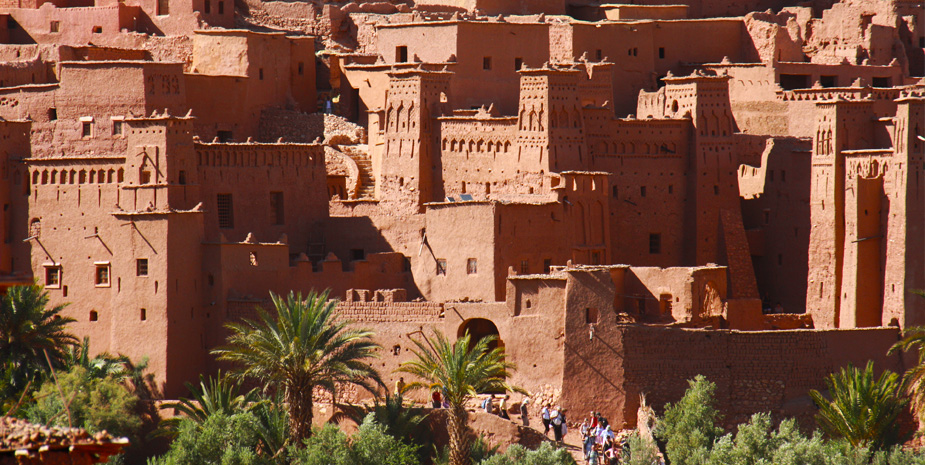The ksar Aït Benhaddou
Located in the foothills on the southern slopes of the High Atlas in the Province of Ouarzazate, the site of Aït BenHaddou is the most famous ksar in the Ounila Valley. The Ksar of Aït-Ben-Haddou is a striking example of southern Moroccan architecture. The ksar is a mainly collective grouping of dwellings. Inside the defensive walls which are reinforced by angle towers and pierced with a baffle gate, houses crowd together – some modest, others resembling small urban castles with their high angle towers and upper sections decorated with motifs in clay brick – but there are also buildings and community areas. It is an extraordinary ensemble of buildings offering a complete panorama of pre-Saharan earthen construction techniques. The oldest constructions do not appear to be earlier than the 17th century, although their structure and technique were propagated from a very early period in the valleys of southern Morocco. The site was also one of the many trading posts on the commercial route linking ancient Sudan to Marrakesh by the Dra Valley and the Tizi-n’Telouet Pass. Architecturally, the living quarters form a compact grouping, closed and suspended. The community areas of the ksar include a mosque, a public square, grain threshing areas outside the ramparts, a fortification and a loft at the top of the village, an caravanserai, two cemeteries (Muslim and Jewish) and the Sanctuary of the Saint Sidi Ali or Amer. The Ksar of Ait- Ben-Haddou is a perfect synthesis of earthen architecture of the pre-Saharan regions of Morocco.
All the structures comprising the ksar are located within the boundaries of the property and the buffer zone protects its environment. The earthen buildings are very vulnerable due to lack of maintenance and regular repair resulting from the abandonment of the ksar by its inhabitants. The CERKAS (Centre for the conservation and rehabilitation of the architectural heritage of atlas and sub-atlas zones) monitors, with difficulty, respect for the visual integrity of the property.
In comparison to other ksour of the region, the Ksar of Ait-Ben-Haddou has preserved its architectural authenticity with regard to configuration and materials. The architectural style is well preserved and the earthen constructions are perfectly adapted to the climatic conditions and are in harmony with the natural and social environment.
The large houses in the lower part of the village, with well conserved decorative motifs, are regularly maintained. The construction materials used still remain earth and wood. The inclination to introduce cement has so far been unsuccessful, thanks to the continued monitoring of the «Comité de contrôle des infractions» (Rural Community, Town Planning Division, Urban Agency, CERKAS). Only a few lintels and reinforced concrete escaped its vigilance, but they have been hidden by earthen rendering. Particular attention is also paid to doors and windows giving on to the lanes, to ensure that the wood is not replaced by metal.
Aït Benhaddou, a famous Shooting Set
A lot of directors have used the natural shooting set of Aït benhaddou in their film. We reckoning the following movies :
- Lawrence Of Arabia (1962)
- Sodom And Gomorrah (1963)
- Oedipus Rex (1967)
- The Man Who Would Be King (1975)
- The Message (1976)
- Jesus of Nazareth (1977)
- Time Bandits (1981)
- Marco Polo (1982)
- The Jewel of the Nile (1985)
- The Living Daylights (1987)
- The Last Temptation of Christ (1988)
- Indiana Jones and the last crusade (1989)
- The Sheltering Sky (1990)
- Kundun (1997)
- The Mummy (1999)
- Gladiator (2000)
- Spy Game (2001)
- Alexander (2004)
- Kingdom of Heaven (2005)
- Babel (2006)
- The hills have eyes (2006)
- One Night with the King (2006)
- Prince of Persia (2010)
- Game of Throne (TV Show 2010)
- Son of God (2014)
- The Queen of Desert (2014)
- Tut (TV Show 2014)










